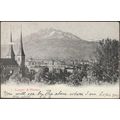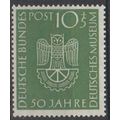St. Brelade's Church, Jersey - Fisherman's Chapel - postcard c.1980s
- Condition : Used
- Dispatch : 2 Days
- Brand : None
- ID# : 138226277
- Quantity : 1 item
- Views : 341
- Location : United Kingdom

- Seller : justthebook (+1703)
- Barcode : None
- Start : Wed 08 Apr 2015 12:11:21 (EDT)
- Close : Run Until Sold
- Remain : Run Until Sold
Checks/Cheques
 for 1 item(s) edit
for 1 item(s) edit
Shipping Calculator
More Listings from This Seller view all
Seller's Description
- Postcard
- Picture / Image: St. Brelade's Church, Jersey, Channel Islands - The Fisherman's Chapel
- Publisher: Pitkin Pictorials Ltd.
- Postally used: no
- Stamp: n/a
- Postmark(s): n/a
- Sent to: n/a
- Notes / condition:
Please ask if you need any other information and I will do the best I can to answer.
Image may be low res for illustrative purposes - if you need a higher definition image then please contact me and I may be able to send one.
------------------------------------------------
Postage & Packing:
Postage and packing charge should be showing for your location (contact if not sure).
No additional charges for more than one postcard. You can buy as many postcards from me as you like and you will just pay the fee above once. (If buying postcards with other things such as books, please contact or wait for invoice before paying).
Payment Methods:
UK - PayPal, Cheque (from UK bank) or postal order
Outside UK: PayPal ONLY (unless otherwise stated) please. NO non-UK currency checks or money orders (sorry).
NOTE: All postcards are sent in brand new stiffened envelopes which I have bought for the task. These are specially made to protect postcards and you may be able to re-use them. In addition there are other costs to sending so the above charge is not just for the stamp!
I will give a full refund if you are not fully satisfied with the postcard.
----------------------------------------------
Text from the free encyclopedia WIKIPEDIA may appear below to give a little background information (internal links may not work) :
*************
The Fishermen's Chapel (French: Chapelle-ès-Pêcheurs, Jèrriais: Chapelle ès Pêtcheurs[1]) is a small chapel located beside St Brelade's Church in St Brelade, Jersey, by the shore at the western end of St Brelade's Bay.
Only a few monastic chapels survived the destruction of over fifty others at the hands of the Reformers in the 16th century. This is one of the few remaining with the exception of some Manorial Chapels, and those at La Hougue Bie.
The name of the chapel is the Chapelle-ès-Pêcheurs, and it was originally thought to be associated with the fishing guilds existing in the Island.[2] More convincingly, Warwick Rodwell has suggested that ""pêcheurs"" (fishermen) is a corruption of "" pécheurs"" (sinners); this agrees with his archaeological investigations which show the chapel to have been a ""chantry chapel"", i.e. a chapel funded by a local family to say masses for the souls of the dead. There is no evidence of ""fishing guilds"".
The walls of this ancient chapel are reputed to date from the middle of the 6th century; some authorities give a later date.
The archaeological work done by Warwick Rodwell place the date of the chapel well after the construction of the main Parish church; because it is smaller, and has no later architectural accretions, it has a more ancient appearance, but this is in fact superficial. However, Rodwell suggests that a primitive wooden structure may have existed on this site as the first ""St Brelade's Church""; this was replaced by the core of the present church in stone, with a site better suited for expansion, the first being used for worship while the second was being built. The wooden structure was then rebuilt as a secondary focus of worship, and later taken over as a Chantry chapel.
The material used in the building is the same as was used in the Parish Church: limpet shells crushed and dissolved with boiling sea-water. The mode of procedure was as follows : they first erected their walling, cased the same on all sides, and then poured the liquid lime-mortar into the wall-work.
The stone roof was raised in the 14th century. The monks of that period evidently found the roof too low and squat for wall paintings. These were discovered in 1918. After a severe storm, colour was revealed on the ceiling and a picture of the ""Assumption"" was seen, but in a damaged condition. But underneath the plaster was found another painting, 'The Annunciation"", of about 1310-1315 A.D. At the foot of this painting are seen fourteen figures, supposedly members of an old Jersey family, the head of which had paid for this painting.
The floor was restored to its earlier level in the 1980s to the Mediaeval level, and the ""low, squat"" aspect of the chapel which appears in early photographs is now gone, as the proper proportions can be seen.
Part of another picture of the Annunciation is to be seen on the south wall behind the arch. A short distance westwards is to be seen the Blessed Virgin's hand clasped on a book resting on a Lectern. Nearby is seen the head of one of the Magi, with the name "" Melchior "" above it, and close by another of the Wise Men bearing the inscription ""les Mages"". Between the Wise Men, the body and legs of a chain-mailed soldier is quite distinct.
On the west wall the subject is the "" Resurrection "" and the ""Last Judgement"". Over the north door is a picture of Herodes Roy—King Herod ; close by is another: "" The Scourging of Christ "". On the North ceiling over the door is a picture of our Lord "" Riding upon an Ass "" ; close by is a picture of a Roman soldier. On the south ceiling in the little Chancel, portions of Adam and Eve and the children are to be seen.
Early histories of the Parish Church of St Brelade [3] made a mistaken identification with Saint Brendan which is undoubtedly wrong. Saint Brelade was also known as Saint Branwalader, and has no connection with St Brendan. However, as a result of this the stained glass windows in the Fisherman's Chapel portray scenes from the life of Saint Brendan.
St Brelade's Church is one of the twelve ancient parish churches in the island of Jersey; it is sited on the west of the island in the parish of St Brelade, in the south-west corner of St Brelade's Bay. It is unique in the Channel Islands in having one of the very few surviving medieval chapels, the Fisherman's Chapel, sited directly next to the main church building.
The church is dedicated to Saint Brelade. Early histories of the church[1] made a mistaken identification with Saint Brendan, which is undoubtably wrong. St Brelade was also known as St Branwalader, and has no connection with St Brendan
The date of the present church is unknown, but it is mentioned in deeds of patronage. In AD 1035, Robert of Normandy confirmed the patronage of the church to the monastery of Montivilliers, which shows that the church was here before 1035.
The chancel is the oldest part of the building. The original building extended some six feet into the nave. It was then only a small monastic chapel.
Early in the 12th century it became a parish church, so additions were made; and in the 14th–15th centuries, the roof was raised some two-and-a-half feet higher to a Gothic pitch. The roof of the Fishermen's Chapel was raised at the same time.
The church of the 12th century was cruciform in structure, consisting of a chancel, a nave (built in two periods) and two transepts—the latter forming the two arms. At a later date, perhaps a century later, the chancel aisle was built, and after that the nave aisle.
The date of the tower is uncertain; it is, however, of later date than the chancel.
Once a rood screen adorned the church; the corbels on which it rested are still in place and a closed-up doorway, through which the rood was approached, is still in existence.
The font disappeared during the Reformation and was found on the slopes near the church, hidden in bracken and gorse, in 1840 and restored to the church. An ornate wooden cover for the font was provided in memory of H. G. Shepard, long-time warden at the church.
Above the font there was presumed to have existed, up to 1843, a smokers' gallery. However, this supposition, first mentioned by Tabb, has no documentary evidence.
A processional cross dating from the 13th century is to be seen in the Lady Chapel; this was found buried in the church.
Nearly all the stone used in the building of this church came from the beach; limpet shells can be noted on the stonework.
The stained glass is the work of Henry Thomas Bosdet and replaced plain glass windows dating from the Reformation iconoclasm.
The carved text on the pulpit is a rendering of Proverbs 25:11: ""Telles que sont les pommes d'or emaillées d'argent, telle est la parole dit comme il faut [A word fitly spoken is like apples of gold in filigree work].""
Before the restoration of Balleine in the 1890s, the whole of the interior stone work was covered in plaster which was whitewashed; the plaster was removed to show the granite, and the whole re-pointed with cement. Balleine's restoration also saw Art Nouveau woodwork in the choir stalls and pulpit and modern paving in the chancel; it is made of five different types of Jersey granite and represents the waves breaking on the sea-shore.
The altar slab, weighing about 15 hundredweight, contains the five crosses cut by the bishop at the time of the church's consecration; the five crosses represent the five wounds of Christ.[citation needed]
type=printed postcards
theme=topographical: british
sub-theme=channel islands
county/ country=jersey
number of items=single
period=1945 - present
postage condition=unposted
Listing Information
| Listing Type | Gallery Listing |
| Listing ID# | 138226277 |
| Start Time | Wed 08 Apr 2015 12:11:21 (EDT) |
| Close Time | Run Until Sold |
| Starting Bid | Fixed Price (no bidding) |
| Item Condition | Used |
| Bids | 0 |
| Views | 341 |
| Dispatch Time | 2 Days |
| Quantity | 1 |
| Location | United Kingdom |
| Auto Extend | No |
















